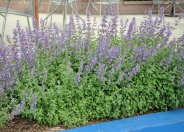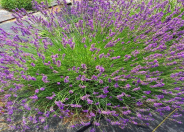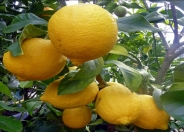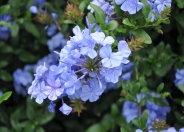
Common name: Catmint
Botanical name: Nepeta x faassenii
Nepeta faassenii makes soft, grey-green, undulating mounds to 1.5' high in bloom, spreading 3'-4' wide. The small leaves are attractive to cats. This perennial has lavender blue flowers in summer. Catmint can be planted in sun or shade and needs medium amount of water. Prune spent flowers to encourage more blooms.

Common name: Chinese Wisteria
Botanical name: Wisteria sinensis
This deciduous vine can quickly and aggressively reach 30' and wide, depending on conditions. It bears rounded clusters of strongly fragrant flowers which open more or less all at once. Cultivars have blue, pink, white, purple or lavender colors, attracting hummingbirds in spring, followed by leafing out of foliage which are usually leaflets, followed by velvety, long, drooping pods. This vine can tolerate full sun to part shade, preferring well draining, rich, moist soil. But it is very reliable and can take drought conditions if established. It looks great in containers and even as a bonsai specimen.

Common name: Grosso Long Stemmed Lavender
Botanical name: Lavandula x intermedia 'Grosso'
Long Stemmed Lavender has beautiful lavender colored plumes in the summer, reaching 3' tall and wide. Fragrance from blooms attract bees. Dried flowers used for sachets, oils, medicinal and culinary uses. Foliage is gray green and thin. This perennial has "fatter" flower spikes than other lavenders. It prefers full sun in well draining soil with low fertilizer. Does not tolerate frost or humidity.

Common name: Improved Meyer Lemon
Botanical name: Citrus x 'Improved Meyer'
Improved Meyer Lemon is an evergreen tree that grows 10' tall and 10-12' wide; it has year-around leaves that are glossy green. This tree likes well drained, loam soil with full sun. Lemon trees do best with lots of mulch around it. Water with drip irrigation or moving a hose around the base. When it's established, water this way, 2 times a month. It has white flowers and yellow edible fruit. Needs protection from the winter cold. Consider using as a potted tree which can brought inside in the winter. Pick up fruit on ground immediately to prevent fungus disease infecting fruit. Fertilize 4 times a year.

Common name: Cape Plumbago
Botanical name: Plumbago auriculata
Plumbago auriculata is an evergreen, climbing shrub native to South Africa that has been introduced in tropical and subtropical climates of Europe, Asia, Africa and the Americas. It is widely cultivated as an ornamental, and is used in traditional medicine and as a source of dye. It has escaped from cultivation and become naturalized outside of its native range.